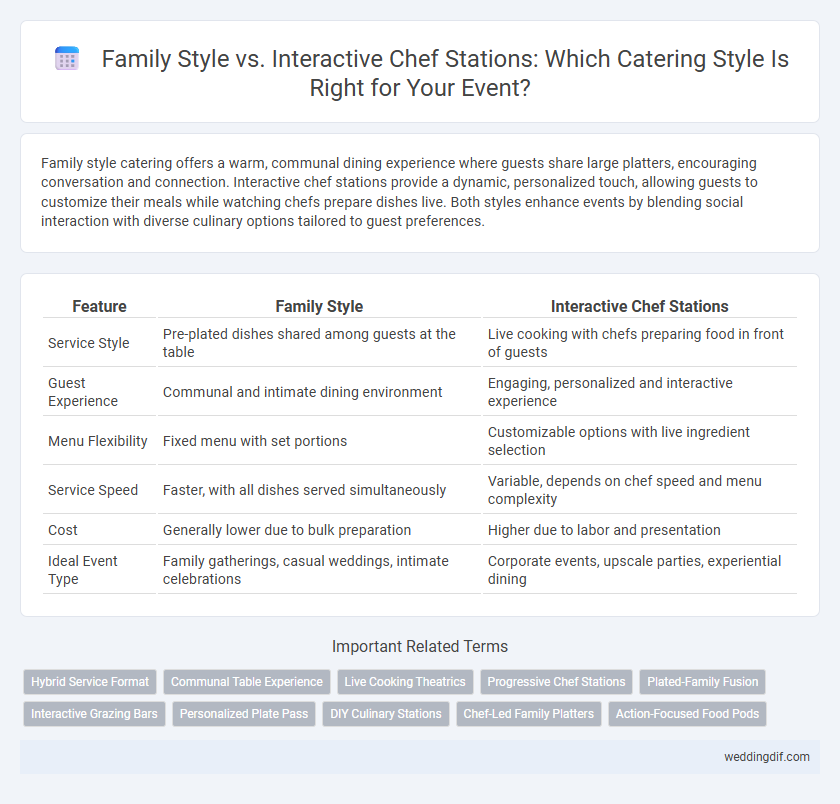Family style catering offers a warm, communal dining experience where guests share large platters, encouraging conversation and connection. Interactive chef stations provide a dynamic, personalized touch, allowing guests to customize their meals while watching chefs prepare dishes live. Both styles enhance events by blending social interaction with diverse culinary options tailored to guest preferences.
Table of Comparison
| Feature | Family Style | Interactive Chef Stations |
|---|---|---|
| Service Style | Pre-plated dishes shared among guests at the table | Live cooking with chefs preparing food in front of guests |
| Guest Experience | Communal and intimate dining environment | Engaging, personalized and interactive experience |
| Menu Flexibility | Fixed menu with set portions | Customizable options with live ingredient selection |
| Service Speed | Faster, with all dishes served simultaneously | Variable, depends on chef speed and menu complexity |
| Cost | Generally lower due to bulk preparation | Higher due to labor and presentation |
| Ideal Event Type | Family gatherings, casual weddings, intimate celebrations | Corporate events, upscale parties, experiential dining |
Understanding Family Style and Interactive Chef Stations
Family Style catering involves serving dishes on large platters for guests to share, promoting communal dining and a warm, inviting atmosphere. Interactive Chef Stations feature live cooking demonstrations where chefs prepare personalized dishes on demand, enhancing guest engagement and offering customizable menu options. Both styles emphasize social interaction but differ in presentation, service pace, and guest participation.
Key Differences Between Family Style and Chef Stations
Family style catering offers communal dishes served on large platters, encouraging guest interaction and shared dining experiences, whereas interactive chef stations feature live cooking with chefs preparing customized dishes on demand, enhancing engagement and personalization. Family style emphasizes ease and a casual atmosphere, while chef stations prioritize entertainment and tailored menu options. Both styles differ in service format, guest involvement, and dining pace, influencing the overall event ambiance and catering logistics.
Guest Experience: Sharing vs. Personalization
Family Style catering fosters a communal dining experience with shared dishes that encourage social interaction and connection among guests. Interactive Chef Stations provide personalized culinary choices, allowing guests to customize their meals for a tailored experience. Both options enhance guest engagement, with Family Style emphasizing togetherness and Interactive Stations highlighting individual preferences.
Menu Variety: Flexibility and Customization
Family style catering offers a fixed menu with multiple dishes shared among guests, allowing limited customization but consistent variety across the table. Interactive chef stations provide greater flexibility, enabling guests to personalize their meals by choosing ingredients and cooking styles, which enhances the overall dining experience with tailored options. Both approaches cater to different event needs, with interactive stations excelling in menu adaptability and family style emphasizing communal dining aesthetics.
Service Flow and Event Atmosphere
Family style catering offers a seamless service flow by delivering shared platters directly to guests, fostering a relaxed and communal event atmosphere. Interactive chef stations create dynamic service points where chefs prepare dishes on demand, enhancing guest engagement and introducing a lively, personalized ambiance. Both methods impact pacing and social interaction differently, with family style emphasizing ease and togetherness, while chef stations highlight entertainment and customization.
Presentation and Visual Appeal
Family Style catering offers a warm, inviting visual appeal with its neatly arranged platters that encourage social interaction and communal dining experiences. Interactive Chef Stations captivate guests through dynamic presentation, showcasing chefs preparing fresh dishes in real time, adding an element of theater and customization. Both styles elevate event aesthetics, but Interactive Chef Stations provide a more engaging and visually stimulating focal point.
Space Requirements and Logistics
Family style catering requires large tables to accommodate multiple platters, demanding ample dining room space and efficient table layout planning to ensure guest comfort and smooth service flow. Interactive chef stations need designated areas with power access and sufficient room for chefs to move safely, posing logistical challenges in event setup and crowd management. Choosing between these options involves assessing venue dimensions, kitchen proximity, and staff coordination to optimize space utilization and operational efficiency.
Budget Considerations and Cost Analysis
Family style catering typically offers a more cost-effective solution by reducing the need for individual plating and minimizing staffing expenses, making it ideal for budget-conscious events. Interactive chef stations, while often resulting in higher per-person costs due to specialized chefs and premium ingredients, provide a customized dining experience that can justify the increased budget for upscale or corporate events. Careful cost analysis should weigh the benefits of guest engagement and presentation against the overall catering budget to determine the most financially viable option.
Dietary Restrictions and Accommodation
Family Style catering offers plated dishes shared among guests, allowing hosts to control portion sizes and menu selections that accommodate common dietary restrictions such as gluten-free, vegetarian, and nut allergies. Interactive Chef Stations provide guests with personalized meal options, enabling real-time accommodation of specific dietary needs like vegan, keto, or dairy-free preferences by customizing ingredients on the spot. Both styles require clear communication with caterers to ensure allergen awareness and safe food handling, enhancing guest satisfaction and safety.
Choosing the Right Style for Your Wedding
Choosing between Family Style and Interactive Chef Stations for wedding catering depends on your guest experience and menu preferences. Family Style offers communal dishes served at tables, encouraging intimacy and conversation, while Interactive Chef Stations provide personalized meals with chefs preparing dishes onsite, adding entertainment and customization. Consider the number of guests, venue layout, and desired atmosphere to select the catering style that best enhances your wedding celebration.
Family Style vs Interactive Chef Stations for catering. Infographic

 weddingdif.com
weddingdif.com